 The Blue Hole by Tami Freed
The Blue Hole by Tami Freed
If you are a diver, there is a good chance the diving the Blue Hole is on your bucket list. And yet, those that do end up diving the Blue Hole are indifferent to whether it is worth doing.
So what is the Blue Hole? It’s basically an underwater sink hole with vertical caves. It is one of many blue holes around the world, however it would have to be the most famous. These sink holes are typically found in low lying coastal areas and others are found In The Bahamas, Guam, in Australia’s Great Barrier Reef and Egypt’s Red Sea.When coming to Central America, I had to get to Belize to see the Blue Hole. I knew I’d be spending some time in Caye Caulker and thought it would be best to take the trip from there. There are three places you can dive the blue hole from, Caye Caulker, Teneriffe and Hopkins. Little did I know at the time was that the journey to the blue hole from Caye Caulker was 2 hours by boat with a 5am morning start! Are you kidding me?!
Making our way to Frenchie’s Diving Centre at 5.30am we walked onto the jetty trying to work out which boat was going to be taking 12 divers and 3 dive masters out for the day. The dive masters were loading the smaller boat on the dock, everyone looked at each other thinking surely this wasn’t the boat taking us out for the day, but it was! It was completely dark when we turned up in the morning, and we watched the sun rise over our journey to the Blue Hole.
The journey to the Blue Hole was to take 2 hours, broken up into a 45 minute rough ride through through bar, an hour journey through the open ocean and the last 15 minutes through reef. We crossed the bar on a rougher day than usual, luckily no one got sick. Doing this route every second day, the captain was well experienced to handle the conditions.
The Blue Hole is an impressive sight from the air, however you really can’t take in all that much while you are within it. The blue hole is huge, it spans 300 metres in diameter. The deep depression is a contrast between dark blue of the deep water to turquoise and light blue of the shallow waters of surrounding it.
Once we arrived the group was divided into open water divers and advanced divers. Open water divers have completed their first diving certification and are permitted to go to 18 metres. The advanced divers were permitted to dive to 30 metres. The benefit of being able to go to the deeper levels mean that divers can see the stalactites as pictured below.
by Caribbean Escape Blog
I was happy to do the shallower dive and I still feel I got a good experience from it. Diving along the rock cave face we saw small fish but barely any marine life. The visibility in the water was quite poor, the water is rather murky making the dive a bit eery. This just added to the experience especially when we saw a huge Caribbean reef shark and what everyone hopes to see while in the blue hole, a hammerhead shark!
After 25 minutes we reached the end of our dive and made our way back onto the boat for some watermelon. We then did our next dive which was at the stunning Half Moon Caye. It was a great way chance to see marine life and coral of Belize’s Caribbean coast. This time we dove for 55 minutes and saw a variety of marine life, colourful corals against deep blue ocean, the sights were amazing.
Taking an hour break for lunch of chicken, rice & beans and coleslaw we stopped on a beautiful little sandy island. It was a pleasant surprise to be spending time on a little tropical oasis of white sand, turquoise waters and coconut trees.
After lunch we made our way to another dive site. I wasn’t feeling well so I sat this dive out and was given the option to snorkel on the reef. Turns out I was a bit dehydrated. Diving dehydrates you and there are little nutrients in the water in this region as it is cleaned so many times making it safe to drink. It was recommended that I buy electrolytes for future dives and to keep hydrated!
About an hour later the divers returned and we made our journey back towards Caye Caulker. We stopped half way back through a reef. The diver masters thanked us for choosing Frenchies and thanked us for a great day. They brought around rum punch and chips and salsa for our afternoon snack.
The journey to Caye Caulker from the reef was much more pleasant the journey to the Blue Hole. We made it back in 1.5hr on fairly calm seas.






